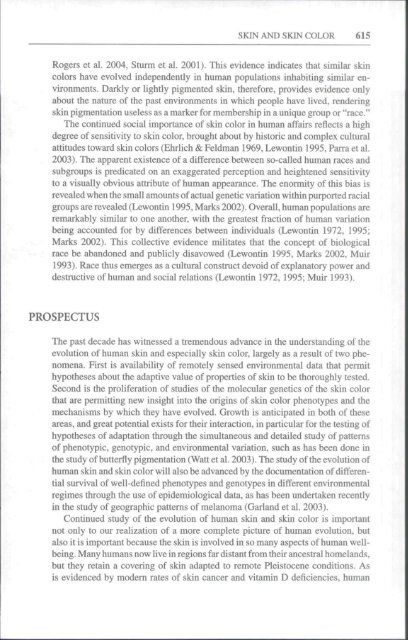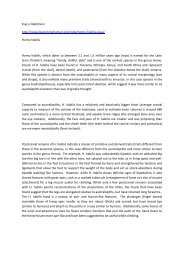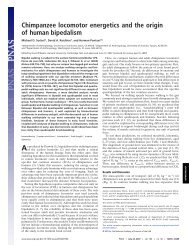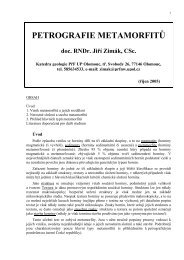THE EVOLUTION OF HUMAN SKIN AND SKIN COLOR Nina G ...
THE EVOLUTION OF HUMAN SKIN AND SKIN COLOR Nina G ...
THE EVOLUTION OF HUMAN SKIN AND SKIN COLOR Nina G ...
Create successful ePaper yourself
Turn your PDF publications into a flip-book with our unique Google optimized e-Paper software.
<strong>SKIN</strong> <strong>AND</strong> <strong>SKIN</strong> <strong>COLOR</strong> 615Rogers et al. 2004, Sturm et al. 2001). This evidence indicates that sitnilar skincolors have evolved independently in human populations inhabiting similar environments.Darkly or lightly pigmented skin, therefore, provides evidence onlyabout the nature of the past environments in which people have lived, renderingskin pigmentation useless as a marker for membership in a unique group or "race."The continued social importance of skin color in human affairs refiects a highdegree of sensitivity to skin color, brought about by historic and complex culturalattitudes toward skin colors (Ehriich & Feldman 1969. Lewontin 1995, Parra et al.2003). The apparent existence of a difference between so-called human races andsubgroups is predicated on an exaggerated perception and heightened sensitivityto a visually obvious attribute of human appearance. The enormity of this bias isrevealed when the small amounts of actual genetic variation within purported racialgroups are revealed (Lewonfin 1995. Marks 2002). Overall, human populations areremarkably similar to one another, with the greatest fraction of human variationbeing accounted for by differences between individuals (Lewontin 1972, 1995;Marks 2002). This collective evidence militates that the concept of biologicalrace be abandoned and publicly disavowed (Lewontin 1995, Marks 2002, Muir1993). Race thus emerges as a cultural construct devoid of explanatory power anddestructive of human and social relations (Lewontin 1972, 1995; Muir 1993).PROSPECTUSThe past decade has witnessed a tremendous advance in the understanding of theevolution of human skin and especially skin color, largely as a result of two phenomena.First is availability of remotely sensed environmental data that permithypotheses about the adaptive value of properties of skin to be thoroughly tested.Second is the proliferation of studies of the molecular genetics of the skin colorthat are permitting new insight into the origins of skin color phenotypes and themechanisms by which they have evolved. Growth is anticipated in both of theseareas, and great potential exists for their interaction, in particular for the testing ofhypotheses of adaptation through the simultaneous and detailed study of pattemsof phenotypic, genotypic, and environmental variation, such as has been done inthe study of butterfly pigmentation (Watt et al. 2003). The study of the evolution ofhuman skin and skin color will also be advanced by the documentation of differentialsurvival of well-defined phenotypes and genotypes in different environmentalregimes through the use of epidemiological data, as has been undertaken recentlyin the study of geographic pattems of melanoma (Garland et al. 2003).Continued study of the evolution of human skin and skin color is importantnot only to our realization of a more complete picture of human evolution, butalso it is important because the skin is involved in so many aspects of human wellbeing.Many humans now live in regions far distant from their ancestral homelands,but they retain a covering of skin adapted to remote Pleistocene conditions. Asis evidenced by modem rates of skin cancer and vitamin D deficiencies, human
















